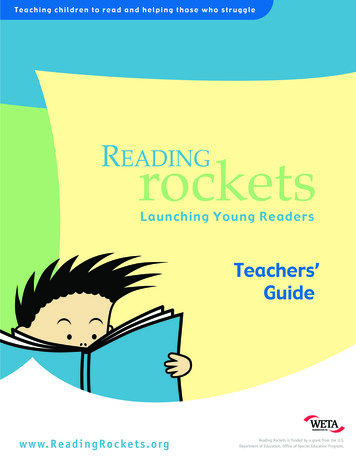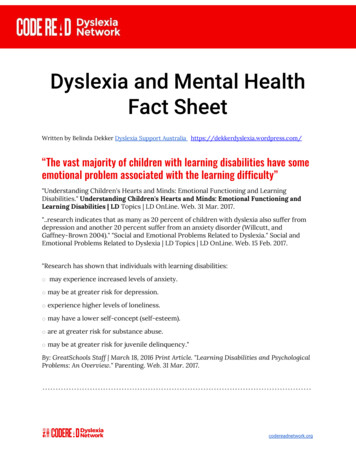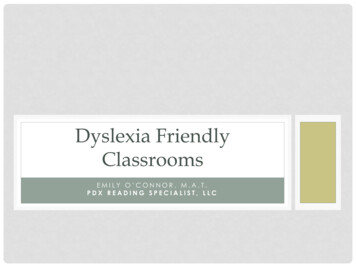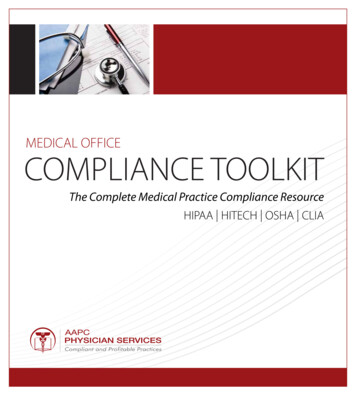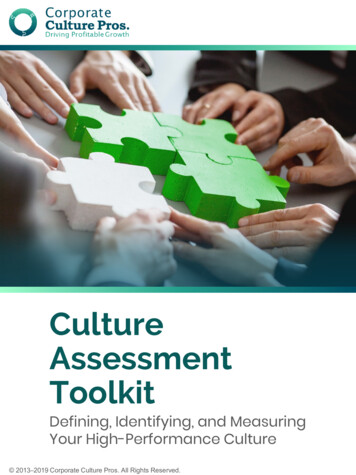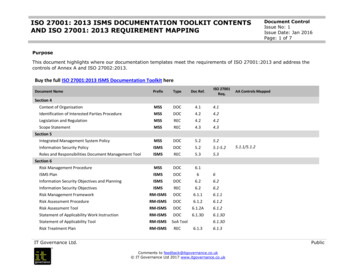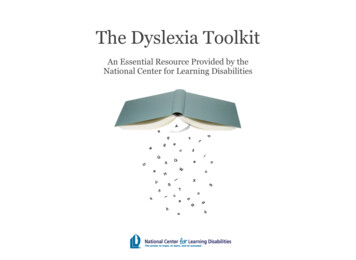
Transcription
The Dyslexia ToolkitAn Essential Resource Provided by theNational Center for Learning Disabilities
Table of ContentsPart One: The BasicsChapter 1: What Is Dyslexia?.2Chapter 2: Common Warning Signs of Dyslexia in Children Pre-K-Grade to 2.5Chapter 3: Common Warning Signs of Dyslexia in Children in Grades 3 to 8.8Chapter 4: Common Warning Signs of Dyslexia in Teens.11Chapter 5: Common Warning Signs of Dyslexia in College Students and Adults.14Chapter 6: Testing for Dyslexia.17Chapter 7: Helpful Dyslexia Resources.20Chapter 8: Video: What Is Dyslexia?.22Part Two: Living and Learning with DyslexiaChapter 9: Can Audio or Digital Books Improve Your Child’s Learning Outcomes?.23Chapter 10: Accommodating Students with Dyslexia.28Chapter 11: Homework 101.31Chapter 12: How Self-Advocacy Can Lead to Innovation: An Interview with Ben Foss.34Chapter 13: Dyslexia: An Obstacle, Not a Limitation.401
C HAPTER 1What Is Dyslexia?As with other learning disabilities, dyslexia is a lifelongchallenge that people are born with. This language processingdisorder can hinder reading, writing, spelling, and sometimes evenspeaking. Before we go further, let’s take a look at howdyslexia can manifest itself in writing:This text was taken from our interview with Stanford Universitygraduate Ben Foss. You’ll find the interview on page 34.It is criticla they you experiment with being publicabout who you are and see what ifeels like not tohide on this issues. It canbe scary to tell peoplethat you are of part of a lable that is associatedwith being lazy or stupid. I have fel this sting. Theday I turned in mt thesis at Stanford Law School,a classmate laughed outloud at the registers officebcause I had the term learning disabilities in mytitle. "They can;t articulate anything!" I looked athim and explained that I had a learning disabilities. He was embarrassed and appologized.Dyslexia is not a sign of poor intelligence or laziness. It is also notthe result of impaired vision. Children and adults withdyslexia simply have a neurological disorder that causes theirbrains to process and interpret information differently.2
Dyslexia occurs among people of all economic and ethnicbackgrounds. Often more than one member of a family hasdyslexia. According to the National Institute of Child andHuman Development, as many as 15 percent of Americanshave major troubles with reading.All of these effects can have a big impact on a person'sself-image. Without help, children often get frustrated withlearning. The stress of dealing with schoolwork often makeschildren with dyslexia lose the motivation to continue andovercome the hurdles they face.Much of what happens in a classroom is based on reading andwriting. So it's important to identify dyslexia as early aspossible. Using alternate learning methods, people withdyslexia can achieve success.What Are the Warning Signs?What Are the Effects of Dyslexia?Dyslexia can affect people differently. This depends, in part,upon the severity of the learning disability and the success ofalternate learning methods. Some with dyslexia can havetrouble with reading and spelling, while others struggle towrite, or to tell left from right. Some children show few signsof difficulty with early reading and writing. But later on, theymay have trouble with complex language skills, such as grammar, reading comprehension, and more in-depth writing.Dyslexia can also make it difficult for people to expressthemselves clearly. It can be hard for them to use vocabularyand to structure their thoughts during conversation. Othersstruggle to understand when people speak to them.It becomes even harder with abstract thoughts and non-literallanguage, such as jokes and proverbs.Dyslexia has different warning signs in people of differentages. See pages 5-16 for more information on signs of dyslexiain different age groups.Everyone struggles with learning at times. Learning disabilities such as dyslexia, however, are consistent and persist overtime. The following lists are a general guide, for identifyingdyslexia. Our Interactive Learning Disabilities Checklist is anadditional resource to consider. Finally, be aware that some ofthe "symptoms" listed also apply to other learning disabilitiesas well as other disorders such as Attention-Deficit/Hyperactivity Disorder (AD/HD), which often co-exist withLD.If you or your child displays several of these warning signs,don't hesitate to seek help. Check off the warning signs thatapply to your child, and take the list to the professional(s) whoyou consult. With proper identification and support, yourchild will be better able to succeed in school, the workplace,and in life. No one knows your child better than you do, sotrust your instincts if you think help is needed.3
How Is Dyslexia Identified?Trained professionals can identify dyslexia using a formalevaluation. This looks at a person's ability to understand anduse spoken and written language. It looks at areas of strengthand weakness in the skills that are needed for reading. It alsotakes into account many other factors. These include familyhistory, intellect, educational background, and socialenvironment.How Is Dyslexia Treated?It helps to identify dyslexia as early in life as possible. Adultswith unidentified dyslexia often work in jobs below theirintellectual capacity. But with help from a tutor, teacher, orother trained professional, almost all people with dyslexia canbecome good readers and writers. Use the following strategiesto help to make progress with dyslexia: Seek modifications in the classroom. This might includeextra time to complete assignments, help with note taking,oral testing, and other means of assessment. Use books on tape and assistive technology. Examples arescreen readers and voice recognition computer software. Get help with the emotional issues that arise from strugglingto overcome academic difficulties.Reading and writing are key skills for daily living. However, itis important to also emphasize other aspects of learning andexpression. Like all people, those with dyslexia enjoy activitiesthat tap into their strengths and interests. For example,people with dyslexia may be attracted to fields that do notemphasize language skills. Examples are design, art,architecture, engineering, and surgery. Expose your child to early oral reading, writing, drawing,and practice to encourage development of print knowledge,basic letter formation, recognition skills, and linguisticawareness (the relationship between sound and meaning). Have your child practice reading different kinds of texts.This includes books, magazines, ads, and comics. Include multi-sensory, structured language instruction.Practice using sight, sound, and touch when introducing newideas.4
C HAPTER 2Common Warning Signs ofDyslexia: Pre-K to Grade 2While dyslexia is most often formally identified in school-agechildren, signs of dyslexia can frequently be detected inpreschoolers.If you’re concerned about your child, review the followingchecklist of common warning signs of dyslexia in children inpre-kindergarten to grade 2.For at least the past six months, my child has had trouble:Language:Learning the alphabet, numbers, and days of the weekNaming people and objectsSpeaking precisely and using a varied, age-appropriatevocabularyStaying on topicGetting or staying interested in stories and booksLearning to speak (delayed compared to his peers)5
Understanding the relationship between speaker andlistenerDistinguishing between letters and words that looksimilarPronouncing words correctly (Example: says “mazagine”instead of “magazine”)Learning and remembering new vocabulary wordsLearning and correctly using new vocabulary wordsDistinguishing words from other words that soundsimilarRhyming wordsKeeping one’s place – and not skipping over words –while readingShowing confidence and interest in readingWriting:Understanding instructions/directionsLearning to copy and write at an age-appropriate levelRepeating what has just been saidWriting letters, numbers, and symbols in the correctorderReading:Naming lettersRecognizing letters, matching letters to sounds, andblending sounds when speakingSpelling words correctly and consistently most of the timeProofreading and correcting written workSocial-Emotional:Learning to read as expected for his/her ageMaking and keeping friendsAssociating letters with sounds, understanding thedifference between sounds in wordsInterpreting people's non-verbal cues, “body language,”and tone of voiceAccurately blending letter sounds within wordsBeing motivated and self-confident about learningRecognizing and remembering sight wordsRemembering printed words6
Other:Sense of direction/spatial concepts (such as left and right)Performing consistently on tasks from day to day7
C HAPTER 3Common Warning Signs ofDyslexia: Grades 3 to 8Are you concerned that your elementary or middle school childisn’t learning, communicating, or relating to others as successfullyas his or her peers? Does your child especially struggle withreading? Is it affecting your child’s confidence and motivation?If so, the following checklist of common warning signs of dyslexiain children in grades 3 to 8 may help clarify your concerns.For at least the past six months, my child has had trouble:Language:Understanding instructions or directionsRepeating what has just been said in proper sequenceStaying on topic and getting to the point (gets bogged down indetails)Naming people and objectsSpeaking with precise, accurate language, proper grammar,and a varied vocabularyDistinguishing between words that sound similar8
Pronouncing words correctlySpeaking smoothly, without much halting or use of "fillerwords" (like "um")Writing letters, numbers, and symbols in the correctorderProofreading and correcting self-generated workRhymingExpressing ideas in an organized way (older children)Understanding humor, puns, and idiomsPreparing/organizing writing assignments (olderchildren)Reading:Reading age-appropriate content with good fluencyFully developing ideas in writing (older children)Listening and taking notes at the same timeReading aloud or silently with good understandingFeeling confident and interested in readingRemembering sight words and other printed wordsLearning and remembering new vocabulary wordsAccurately analyzing unfamiliar words (tends to guessinstead)Reading words and letters in the correct order, seldomreversing or skipping over themUnderstanding word problems in mathWriting:Mastering spelling rulesSocial-Emotional:Participating in a peer group and maintaining positivesocial statusInterpreting people's non-verbal cues, "body language,"mood, and tone of voiceDealing with peer pressure, embarrassment, andexpressing feelings appropriatelySetting realistic social goalsMaintaining positive self-esteem about learning andgetting along with othersMaintaining confidence about “fitting in” with hisclassmates and other peersSpelling the same word consistently and correctly9
Other:Learning/remembering new skills; relies heavily onmemorizationRemembering facts and numbersSense of direction/spatial concepts (such as left andright)Performing consistently on tasks from day to dayApplying skills from one situation to anotherLearning new games and mastering puzzles10
C HAPTER 4Common Warning Signs ofDyslexia: TeensAre you concerned because your teen is struggling with academiclearning in school? Have you noticed any social awkwardness ora tendency to keep a distance from peers? Does lack of motivation seem to be a problem? Do you worry about whether lowself-esteem is taking the joy out of learning?These may all be signs of a not-yet-identified learning disability(LD) such as dyslexia. Look over the following checklist ofcommon warning signs of dyslexia in teens.For at least the past six months, my teen has had trouble:Language:Speaking fluently (not haltingly) and precisely, using a richvocabularyUnderstanding instructions/directionsUsing correct grammar and vocabularyUnderstanding the relationship between speaker andlistener; participating in conversation appropriately11
Staying on topic and getting to the point (gets boggeddown in details)Summarizing a storyPreparing an outline for written workExpressi
graduate Ben Foss. You’ll find the interview on page 34. Dyslexia is not a sign of poor intelligence or laziness. It is also not the result of impaired vision. Children and adults with dyslexia simply have a neurological disorder that causes their brains to process and interpret information differently. It is criticla they you experiment with being public about who you are and see what .
